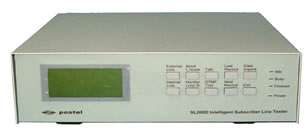
The design of SL200D is based on the modern electronic measuring technology, digital signal processing technology, microprocessor control technology, digitized voice technology, etc. SL200D integrates the most functions of exchange subscriber line testing unit (TU) and traditional manual subscriber line testing board. Few training of operator! One- person operation and remote operation are available. It works by plugging test core into main distribution frame (MDF) directly and the fault inside and outside the MDF can be distinguished. Exchange types are not concerned. Ten items data of subscriber line can be obtained automatically in about 5 seconds and the fault type, such as line broken, line touching, touching negative voltage, touching ground, insufficient insulation, etc., can be judged automatically. The fault type is displayed in LCD and played via voice simultaneously. The further functions, such as listening to dial tone, supplying -48V supply, ringing, talking, DTMF checking, loop resistance testing, data storage, are also available. SL200Ds are widely used in the routine maintenance and telephone installation in various exchange testing rooms

● Can be operated by only one person.
● Test by plugging test core into MDF directly. Exchange types not concerned.
● Two operation ways: panel keyboard and remote keyboard.
● External Line (it means the subscriber line outside the MDF): The data of DC voltage, AC voltage, resistance and capacitance for A-B, A-Ground, B-Ground (total 10 items) can be obtained in about 5 seconds and the fault types can be recognized auto- matically. The fault types are: line normal, line broken, line touching, touching ground, touching negative voltage,insufficient
● insulation. The fault type is displayed in LCD and played out via speaker simultaneously.
● Internal Line (it means the subscriber line inside the MDF): The dial tone can be played out by the attached speaker and the operator can judge if the internal line is normal according to what the speaker is playing.
● Send L. Voice: SL200D sends line checking voice to the subscriber line. And so the outside operator can recognize the line pair by connecting the phone to the line pair and listening to the phone.
● Monitor Loop R.: Be capable of monitoring (testing) the loop resistance of lines continuously. The results are displayed in LCD and played out via the speaker continuously, respectively.
● Talk: Be capable of supplying -48V supply and ringing. When off-hook, the operator can talk to the subscriber.
● DTMF Test: Ringing. When off-hook, talk to the subscriber and ask him/her to press the dial keys. The LCD displays the corresponding key number.
● Data Inquire: 50 record items of testing can be stored in scroll way for inquiry.
● Last Record/Next Record: To inquire the last record/next record.
● Exit: Exit to the initial state.
● Simple operation. When test core is plugged into the MDF, the operator can press the remote keyboard attached the core, then the test result can be heard directly without moving frequently.
● LCD prompts for operation.
● Fast test speed. Subscriber line testing and result recognizing can be finished in about 6 seconds.
● Be capable of testing the subscriber line for which a phone number has not been assigned.
● Accuracy > 98%.


